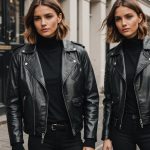Ultimate Guide to Sustainable Fashion Blogging in the UK: Eco-Conscious Strategies for Success
In the ever-evolving world of fashion, the shift towards sustainability is no longer a trend, but a necessity. As a fashion blogger in the UK, embracing eco-friendly strategies not only aligns with the growing demand for sustainable living but also enhances your brand’s credibility and appeal. Here’s a comprehensive guide on how to make your fashion blog a beacon of sustainability in the industry.
Embracing Responsible Sourcing
Responsible sourcing is at the heart of sustainable fashion blogging. Here’s how you can ensure that your blog promotes and practices responsible sourcing:
This might interest you : Achieving Perfect Foundation: Expert Techniques for Flawless Freckle-Friendly Makeup
Collaborate with Sustainable Suppliers
Collaborating with suppliers who adhere to high sustainability standards is crucial. For instance, Stella McCartney works with Chargeurs Luxury Materials and Keel Labs, which focus on regenerative farming and innovative seaweed fabrics. When you partner with such suppliers, you not only ensure the sustainability of the materials but also educate your audience about the importance of responsible sourcing[1].
Highlight the Sourcing Process
Transparency is key in sustainable fashion. Highlighting the sourcing process in your blog posts can educate your readers about the journey of the clothes from raw materials to the final product. This includes discussing the ethical and environmental standards of your suppliers and how they impact the environment and the people involved in the production process.
Also to read : Ultimate Guide to At-Home Hair Bleaching: Top Tips for Safe, Damage-Free Results!
Promoting Circular and Slow Fashion
Fast fashion has been a significant contributor to waste and environmental degradation. Here’s how you can promote a more sustainable approach:
Circular Fashion
Circular fashion is about extending the life of clothes and reducing waste.
- Reuse, Repair, Resale: Encourage your readers to extend the life of their clothes through reuse, repair, and resale. This can include tips on DIY repairs and styling old clothes in new ways.
- Upcycling: Showcase creative ways to upcycle old clothes into new, unique pieces. This not only reduces waste but also fosters creativity and sustainability[1].
Slow Fashion
Slow fashion is about investing in quality over quantity.
- Quality Over Quantity: Advocate for investing in high-quality, long-lasting clothing rather than cheap, disposable items. Brands like Reformation are already on this path, focusing on slow-impact materials and energy-efficient practices.
- Seasonless Fashion: Promote seasonless fashion trends that are not bound by the fast-paced cycle of seasonal collections. This approach encourages timeless pieces that can be worn year-round[1].
Collaborating with Sustainable Influencers
Sustainable influencers have a significant impact on consumer behavior and can be powerful allies for your blog.
Finding the Right Influencers
Look for influencers who genuinely care about sustainability and have a consistent message. Francesca Willow (Ethical Unicorn), Robin Greenfield, and Kelly Eastwood (The London Chatter) are examples of influencers who are deeply committed to sustainable living. These influencers can help amplify your message and reach a broader audience[1].
Building Meaningful Partnerships
Create authentic partnerships by sharing your brand’s vision and sustainability efforts with the influencers. This mutual support can help you reach a broader audience while promoting sustainable practices. Plan influencer campaigns that tell a story about sustainable materials, production processes, and the environmental impact of fashion choices. For example, you could collaborate on a special edition product line inspired by the influencer’s style and eco-friendly values[1].
Avoiding Greenwashing and Ensuring Transparency
Greenwashing is a common pitfall in the sustainability journey. Here’s how to avoid it and ensure transparency:
Authentic Sustainability Claims
Be honest and transparent about your brand’s sustainability efforts. Avoid making claims that are not backed by real actions. For instance, H&M has faced criticism for its insincere sustainable fashion claims, which can damage brand credibility. Ensure that any sustainability claims you make are supported by concrete actions and data[1].
Transparent Supply Chain
Provide detailed information about your supply chain and the environmental impact of your products. Brands like Reformation use tools like RefScale to track their carbon and water footprint, ensuring transparency and accountability. This transparency helps build trust with your audience and demonstrates your commitment to sustainability[1].
Practical Tips for Eco-Friendly Fashion Blogging
Here are some practical tips to make your fashion blog more eco-friendly:
Eco-Friendly Outfit Tips
- Second-Hand Shopping: Encourage readers to explore second-hand stores and online platforms for unique, sustainable fashion finds.
- Quality Over Trend: Advocate for investing in timeless pieces rather than following fast fashion trends.
- Care and Maintenance: Provide tips on how to care for clothes to extend their lifespan, such as washing at lower temperatures and avoiding over-drying[1].
Sustainable Living Tips
- Zero Waste Lifestyle: Share tips on adopting a zero-waste lifestyle, inspired by pioneers like Bea Johnson. This includes refusing single-use plastics, reducing consumption, and recycling effectively.
- Green Living: Offer advice on broader green living practices, such as using public transportation, reducing energy consumption, and using eco-friendly cleaning products[1].
Highlighting Ethical and Sustainable Brands
There are numerous ethical and sustainable brands in the UK that you can feature on your blog to inspire your readers.
Examples of Sustainable Brands
Here are a few examples of sustainable brands you might consider:
- Beaumont Organic: Known for its beautiful casual clothing made from sustainable fabrics like GOTS-certified organic cotton, linen, and lyocell. Beaumont Organic also offers free repairs to extend the lifespan of their garments[2].
- Existential Thread: Makes vegan-friendly leisure and casual wear in GOTS-certified and Fair Wear Foundation-approved facilities. They print items to order to avoid waste and use plastic-free packaging[2].
- Girlfriend Collective: Offers inclusively-sized and ethically-made activewear from recycled materials. They also have a program to take back old items and turn them into new ones, promoting circularity[2].
- Komodo: Uses premium quality organic, natural, and eco-friendly fibers and is a member of the Soil Association. Komodo also donates to the Sumatran Orangutan Society and has eliminated single-use plastics from its supply chain[2].
Table: Comparing Sustainable Fashion Brands
Here is a comparative table of some sustainable fashion brands in the UK:
| Brand | Budget | Sizes Available | Materials Used | Additional Sustainability Efforts |
|---|---|---|---|---|
| Beaumont Organic | ££ – £££ | 8 – 20 | Organic cotton, linen, lyocell | Free repairs, EU-based factories with fair wages and good working conditions |
| Existential Thread | £ | 6 – 20 | GOTS-certified organic cotton | Printed to order, plastic-free packaging, works with Thread Ahead charity |
| Girlfriend Collective | ££ | XS – 6XL | Recycled materials | Circular program for old items, eco-friendly dyes |
| Komodo | ££ | 8 – 16 | Organic, natural, eco-friendly fibers | Member of Soil Association, donates to Sumatran Orangutan Society, no single-use plastics |
| MUD Jeans | ££ | 26″ – 36″ | Recycled denim | Uses ozone and laser processes to reduce water use, cruelty-free and vegan-friendly |
Leveraging Social Media for Sustainable Fashion
Social media is a powerful tool for promoting sustainable fashion and engaging with your audience.
Content Strategy
Develop a content strategy that focuses on sustainable fashion practices. Here are some tips:
- Educational Posts: Share articles, videos, and infographics about the environmental and social impact of fast fashion versus sustainable fashion.
- Outfit of the Day (OOTD) Posts: Feature sustainable outfits and explain the eco-friendly materials and practices behind each piece.
- Influencer Collaborations: Collaborate with sustainable influencers to reach a broader audience and amplify your message.
- Behind-the-Scenes Content: Share behind-the-scenes looks at sustainable fashion brands, their production processes, and their commitment to sustainability[1].
Engaging with Your Audience
Engage with your audience by asking for their feedback and suggestions on sustainable fashion. Use social media platforms to host Q&A sessions, polls, and discussions on sustainable fashion topics. This not only builds a community but also provides valuable insights into what your audience is looking for in sustainable fashion content.
Addressing Climate Change Through Sustainable Fashion
Climate change is one of the most pressing issues of our time, and the fashion industry plays a significant role in it.
Reducing Carbon Footprint
Encourage your readers to reduce their carbon footprint by choosing sustainable fashion options. Here are some ways to do this:
- Choose Organic Cotton: Organic cotton has a lower environmental impact compared to conventional cotton. Brands like Beaumont Organic and Existential Thread use organic cotton in their products[2].
- Opt for Second-Hand Shopping: Second-hand shopping reduces the demand for new, resource-intensive clothing. Encourage your readers to explore second-hand stores and online platforms[1].
- Support Brands with Sustainable Practices: Highlight brands that have implemented sustainable practices such as using renewable energy, reducing water consumption, and minimizing waste.
Quoting Experts
As Kelly Eastwood (The London Chatter) aptly puts it, “Sustainability doesn’t have to compromise on style. It’s about making conscious choices that benefit both you and the planet.” This quote encapsulates the essence of sustainable fashion blogging, where style and sustainability go hand in hand[1].
Building a Community Around Sustainable Fashion
Building a community around sustainable fashion is crucial for driving change.
Community-Led Initiatives
Initiatives like Sustainable Fashion Week (SFW) are community-led and focus on empowering people with skills and resources to drive a positive shift in the fashion industry. SFW brings together organizations, brands, makers, and activists to build a powerful collective and amplify their work[3].
Engaging Content
Create engaging content that inspires your readers to join the sustainable fashion movement. Here are some ideas:
- Sustainable Fashion Challenges: Host challenges where readers can share their sustainable fashion choices and tips.
- Guest Posts: Invite sustainable fashion experts and influencers to write guest posts for your blog.
- Webinars and Workshops: Organize webinars and workshops on sustainable fashion topics, such as upcycling, DIY repairs, and sustainable styling.
Running an eco-friendly fashion blog in the UK is not just about following trends; it’s about making a meaningful impact on the environment and consumer behavior. By embracing sustainable materials, promoting circular and slow fashion, collaborating with sustainable influencers, reducing waste, and ensuring transparency, you can create a blog that is both stylish and sustainable.
As you embark on this journey, remember that every small step towards sustainability counts, and together, we can make a significant difference. Here are some final tips to keep in mind:
- Stay Informed: Keep up-to-date with the latest trends and practices in sustainable fashion.
- Be Authentic: Ensure that your sustainability claims are backed by real actions and data.
- Engage Your Audience: Build a community around sustainable fashion by engaging with your readers and encouraging their participation.
By following these strategies, you can make your fashion blog a beacon of sustainability in the industry, inspiring your readers to make eco-friendly choices in their daily lives.






